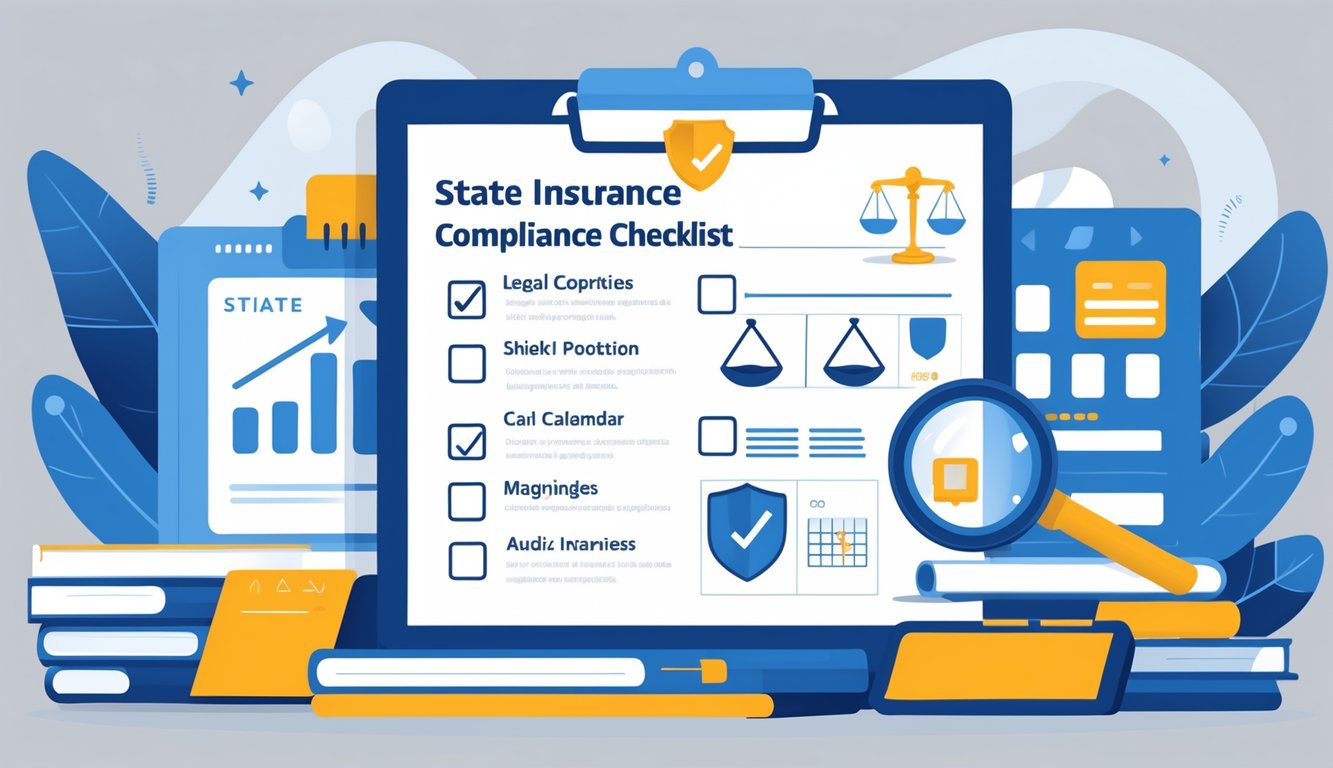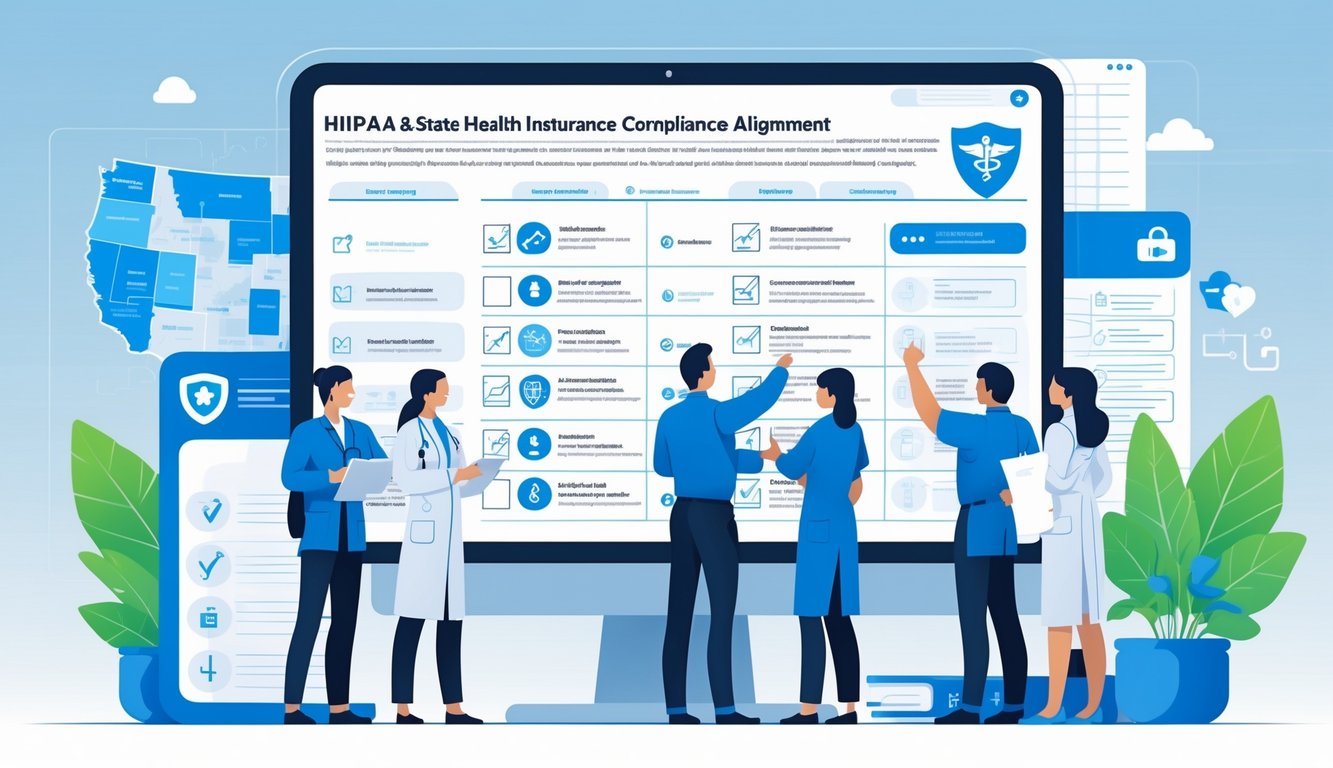Managing state insurance compliance can feel overwhelming, honestly.
You need a system that covers regulatory requirements, documentation, and keeps you in line with federal healthcare privacy laws.
Every state has its own insurance rules, and they seem to change all the time.
Insurance professionals really have to keep their checklists and monitoring systems up to date.

A good state insurance compliance checklist keeps you on track with regulations and helps you avoid expensive penalties. If you don’t stay on top of compliance, your company could get hit with fines, lose licenses, or end up in legal trouble, which can seriously mess with your business.
State insurance regulations can get complicated fast.
You need clear steps for licensing, consumer protection, and data privacy.
If you know how state rules line up with federal regulations like HIPAA compliance standards, you’re better prepared to cover all your bases.
Key Takeaways
- You have to track licensing, documentation, and regulatory requirements for each state
- Good compliance checklists help you dodge penalties and business interruptions
- Matching up state insurance requirements with federal privacy laws keeps both your business and your clients safer
Core Elements of a State Insurance Compliance Checklist

State insurance compliance means you need the right employer identification, solid employment documentation, enough insurance coverage, and accurate recordkeeping.
These four areas really are the backbone of your legal responsibilities as an employer.
Required Employer Identification and Registration
Your business has to get and keep a few key identification numbers.
The big one is your EIN (Employer Identification Number) from the IRS.
You also need a state tax account number from your state’s revenue department.
This lets you handle state income tax returns and other tax stuff.
A separate state employment tax account is necessary for unemployment insurance contributions.
States set their own registration requirements and deadlines, so you’ll want to check those.
Some states ask for extra registrations for programs like disability insurance or paid family leave.
Make sure you look up your state’s rules within 30 days of hiring your first employee.
Keep all your registration docs and account numbers handy.
You’ll need them for taxes, insurance, and official letters.
Mandatory Employment Policies and Documents
Federal and state laws require you to display certain workplace posters and keep specific employee documents. Employment posters need to go somewhere every employee can see them.
These posters usually cover minimum wage, workers’ comp info, and anti-discrimination policies.
Some states add more, like family leave or safety rules.
Every employee fills out Form I-9 to prove they can work in the U.S. Keep these forms separate from other files and follow the rules for how long to keep them.
A lot of states make you give new hires a wage notice.
This tells them about their pay rate, pay periods, and deductions.
Update your posters when laws change.
Missing or outdated posters can cost you thousands per violation.
Insurance Coverage and Benefits Obligations
Workers’ compensation insurance is required in most states if you have employees.
The rules change depending on where you are and your industry.
Some states require disability insurance to help employees who get hurt or sick outside of work. Paid family leave might be mandatory too.
Health insurance requirements depend on your business size and state laws.
If you’ve got 50 or more full-time employees, you have to offer coverage under federal law.
You can also look into Individual Coverage Health Reimbursement Arrangements (ICHRA) or Qualified Small Employer Health Reimbursement Arrangements (QSEHRA).
These let you reimburse employees for their own health insurance premiums.
Check your coverage limits and renewal dates every year.
Keep your insurance certificates and policy documents in order for audits or claims.
Payroll, Tax, and Wage Recordkeeping
You need to keep accurate payroll records: hours worked, pay, and all deductions.
Track paid time off accruals and how employees use their time.
Keep tabs on unused paid time off and what you owe for it.
Some states make you pay out unused vacation when someone leaves.
Record mileage reimbursement payments using the current IRS rate.
Hold on to receipts and payment vouchers for every business expense.
File your tax returns on time, including Schedule H if you have household employees.
Send out Form W-2 to each worker and Form W-3 to the Social Security Administration by January 31st.
Give termination notices as your state requires.
Some states have rules about when and what you need to tell employees who are leaving.
Store all records for as long as federal and state law says—usually three to seven years.
HIPAA and State Health Insurance Compliance Alignment

State insurance compliance means you have to juggle both federal HIPAA regulations and your state’s health data protection rules.
New changes to Part 2 regulations and ongoing HIPAA Security Rule updates bring in more compliance obligations for breach notification and substance use disorder record handling.
HIPAA and State Regulatory Requirements
You deal with both HIPAA and state insurance regulations when handling protected health information (PHI).
The Centers for Medicare and Medicaid Services (CMS) works with state agencies to keep everyone in line.
Your organization should figure out how new HIPAA regulations in 2025 will affect your state compliance.
The Office for Civil Rights (OCR) has proposed some Security Rule updates that’ll probably mean investing more in cybersecurity.
Key Federal-State Coordination Areas:
- HIPAA Privacy Rule and state privacy laws
- Security standards for electronic protected health info (ePHI)
- Civil monetary penalties from both federal and state enforcement
- Licensing for healthcare providers
State regulators often want stricter protections than HIPAA requires.
When state and federal rules clash, you have to go with the stricter one.
The HITECH Act lets state attorneys general go after HIPAA violations, so you could face both federal and state actions for the same issue.
Breach Notification and Data Security
Your breach notification process has to meet both HIPAA’s Breach Notification Rule and your state’s insurance department rules.
Many states want you to notify people faster than the federal 60-day rule.
Healthcare cybersecurity is a big deal now, with cyberattacks on the rise.
The new HIPAA Security Rule update will probably add more cybersecurity requirements and increase your costs.
Breach Notification Requirements:
- Federal: 60 days to notify individuals, 60 days for OCR
- State: Often 30 days or less for the insurance commissioner
- Media: If 500+ people in one state are affected, you have to notify the media
You need to use cybersecurity best practices that go beyond the basics.
The healthcare sector is pushing for better threat detection and response.
State insurance departments sometimes team up with OCR on big data breach investigations.
Your incident response plan should cover both federal and state reporting at the same time.
Personal health apps and third-party vendors add more compliance headaches.
Make sure your business associate agreements cover both HIPAA and state-specific rules.
Substance Use Disorder and Part 2 Regulation Compliance
Changes to 42 CFR Part 2 now line up more closely with HIPAA, which means new rules for handling substance use disorder (SUD) records.
The Substance Abuse and Mental Health Services Administration (SAMHSA) finalized these updates in 2024.
You can now get broad consent for treatment, payment, and healthcare operations (TPO) instead of asking every time you disclose SUD records.
This makes care coordination easier while still protecting patient privacy.
Part 2 Compliance Changes:
- Broad TPO consent is now okay for SUD records
- HIPAA breach notification rules apply
- Minimum necessary standard applies to disclosures
- Patients get a broader right to know who’s seen their info
Some states set even stricter rules for SUD records than federal law.
Check your state’s confidentiality laws—they might be more protective.
You’ll need to update your Notice of Privacy Practices to include Part 2 protections.
Your HIPAA compliance checklist should now cover Part 2 requirements too.
SUD counseling notes still need their own specific consent and can’t be shared under broad TPO consent.
Make sure your policies clearly separate general SUD records from counseling notes.
Frequently Asked Questions

Insurance companies deal with a lot of requirements for annual filings, document submissions, and state-specific compliance standards.
Each state has its own deadlines, forms, and processes, so you need to pay close attention or risk penalties.
What are the mandatory documents required for the annual state insurance compliance filing?
For your annual state insurance compliance filing, you’ll usually need audited financial statements, actuarial reports, and forms specific to your state.
Most states want your company’s balance sheet, income statement, and cash flow statement prepared according to statutory accounting rules.
You have to submit your annual statement using the NAIC Annual Statement format.
That includes Schedule A for real estate, Schedule B for mortgages, and Schedule D for bonds and stocks.
Some states want extra documents like market conduct reports, complaint logs, or regulatory capital calculations.
Always check your state’s requirements, since they might want more than just the standard NAIC stuff.
How can I ensure my company meets all NAIC state-specific requirements for insurance compliance?
Start by checking your state insurance department’s website for the latest filing requirements and deadlines.
States post instructions about required forms, fees, and how to submit everything.
Your compliance team needs to keep an eye on any changes to state regulations during the year.
States update their rules, and you don’t want to send in the wrong info.
Think about using CLIA quality standards to keep your process consistent.
Set up a checklist and assign each task to someone on your team.
What steps must be taken to adhere to the Oklahoma Department of Insurance annual filing checklist?
You need to file your annual statement with the Oklahoma Insurance Department by March 1st.
This includes the NAIC Annual Statement, audited financials, and Oklahoma-specific forms.
Oklahoma asks for your actuarial opinion and memorandum with your filing.
You’ll also need to include management’s discussion and analysis if your company meets certain premium levels.
Pay the right filing fees when you send everything in.
Oklahoma’s fees change depending on your company type and premium size, so double-check the current schedule before you file.
Can you outline the process for completing the Florida property and casualty insurance compliance checklist?
Florida wants property and casualty insurers to file annual statements by March 1st using the System for Electronic Rate and Form Filing (SERFF).
You’ll need to set up an account and upload all the required documents online.
Your Florida filing must have Form OIR-B1-1820 for financial reporting and Form OIR-B1-1821 for market share data.
If you’re subject to it, you need to submit hurricane catastrophe fund reporting too.
Florida also requires extra reports for windstorm coverage and claims-paying ability.
Your company has to show you have enough reserves and capital for possible hurricane losses.
What are the key deadlines and submission instructions for New York property and casualty insurance filings?
New York wants your annual statement by March 1st through the Department of Financial Services’ online portal.
You’ll need to register and submit everything electronically.
Your filing has to include the standard NAIC Annual Statement plus New York Regulation 118 exhibits.
You must send in your independent auditor’s report and management letter within 60 days of your fiscal year end.
New York also requires quarterly financial statements due 45 days after each quarter.
You must keep minimum surplus levels and notify the state right away if your surplus drops below the required amount.
Which updates or changes were implemented in the NAIC compliance checklist for the year 2025?
The NAIC rolled out new cybersecurity reporting rules for 2025 annual statements.
Now, your company needs to fill out extra data security schedules.
If any cyber incidents happened during the year, you have to report those too.
Starting in 2025, larger insurers face new climate risk disclosure rules.
You’ll need to share your company’s climate-related financial risks, plus your strategies for handling them, by answering the new NAIC climate risk interrogatories.
The NAIC changed its group capital calculation requirements for 2025 as well.
If your company belongs to an insurance holding company system that fits certain criteria, you might have to file more group supervision reports.


